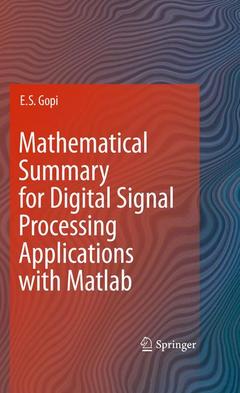1. Matrices. 1-1 Properties of vectors. 1-2 Properties of Matrices. 1-3 LDU Decomposition of the arbitrary matrix. 1-4 PLDU Decomposition of the arbitrary matrix. 1-5 Vector space and its properties. 1-6 Linear independence, Span, Basis and the Dimension of the Vector Space. 1-7 Four Fundamental Vector spaces of the Matrix. 1-8 Basis of the Four Fundamental Vector spaces of the Matrix. 1-9 Observations on the Results of the Example 1-12. 1-10 Vector Representation with different basis. 3-11 Linear transformation of the vector. 1-12 Transformation matrix with different basis (Similar Matrices). 3-13 Orthogonality. 1-14 System of Linear Equation. 1-15 Solutions for the system of Linear Equation [A] x = b. 1-16 Gram-Schmidt Orthogonalization procedure for obtaining orthonormal basis. 1-17 QR Factorization. 1-18 Eigen values and the Eigen Vectors. 1-19 Geometric Multiplicity (vs) Algebraic Multiplicity. 1-20 Diagonalization of the matrix. 1-21 Schur’s Lemma. 1-22 Hermitian Matrices. 1-23 Unitary Matrices. 3-24 Normal Matrices. 1-25 Applications of Diagonalization of the non-deficient matrix. 1-26 Singular Value Decomposition(SVD). 1-27 Applications of Singular Value Decomposition. 2. Probability. 2-1 Introduction. 2-2 Axioms of Probability. 2-3 Class of Events or Field(F). 2-4 Probability Space (S,F,P). 2-5 Probability measure. 2-6 Conditional Probability. 2-7 Total Probability Theorem. 2-8 Bayes Theorem. 2-9 Independence. 2-10 Multiple Experiments. 2-11 Random Variable. 2-12 Cumulative Distribution Function(cdf) of the random variable ‘x’. 2-13 Continuous Random variable. 2-14 Discrete Random variable. 2-15 Probability mass function. 2-16 Probability density function. 2-17 Two Random variables. 2-18 Conditional distributions and densities. 2-19 Independent Random variables. 2-20 Some Important results on conditional density function. 2-21 Transformation of the Random variables of the type Y=g(X). 2-22Transformation of the Random variables of the type Y1=g1(X1,X2), Y2=g2(X1,X2). 2-23 Expectations. 2-24 Indicator. 2-25 Moment Generating function. 2-26 Characteristic function. 2-27 Multiple Random Variable (Random Vectors). 2-28 Gaussian random vector with mean vector µx and covariance matrix Cx. 2-29 Complex Random variables. 2-30 Sequence of the Number and its convergence. 2-31 Sequence of the functions and its convergence. 2-32 Sequence of the Random variable. 2-33 Example for the sequence of random variable. 2-34 Central Limit Theorem. 3. Random Process. 3-1 Introduction. 3-2 Random variable Xt1. 3-3 Strictly stationary Random Process with order 1. 3-4 Strictly stationary Random Process with order 2. 3-5 Wide Sense stationary Random Process. 3-6 Complex Random Process. 3-7 Properties of Real and Complex Random Process. 3-8 Jointly Strictly Stationary of two Random Process. 3-9 Jointly Wide Sense Stationary of two Random Process. 3-10 Correlation matrix of the random column vector [Xt Xs] for the specific ‘t’ and ‘s’. 3-11 Ergodic process. 3-12 Independent Random process. 3-13 Uncorrelated Random process. 3-14 Random process as the input and output of the system. 3-15 Power Spectral density. 3-16 White Random process. 3-17 Gaussian Random process. 3-18 Cyclo stationary Random process. 3-19 Wide sense Cyclo stationary Random Process. 3-20 Sampling and Reconstruction of the Random Process. 3-21 Band Pass Random Process. 3-22 Random Process as the input to the Hilbert transformation as the system. 3-23 Two jointly W.S.S Low pass Random process obtained using W.S.S. Band pass Random process and its Hilbert transformation. 4. Linear Algebra. 4-1 Vector space. 4-2 Linear Transformation. 4-3 Direct Sum. 4-4 Transformation Matrix. 4-5 Similar Matrix. 4-6 Structure Theorem. 4-7 Properties of Eigen Space. 4-8 Properties of Generalized Eigen space. 4-9





